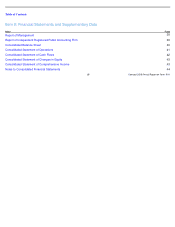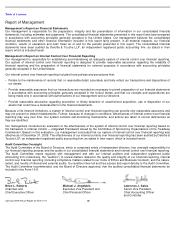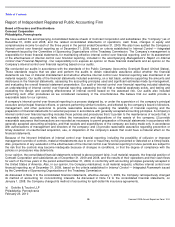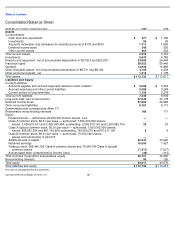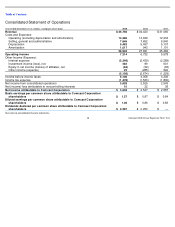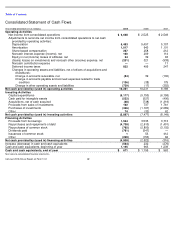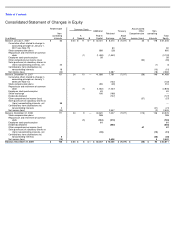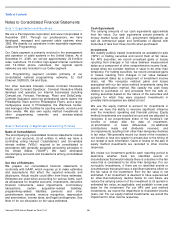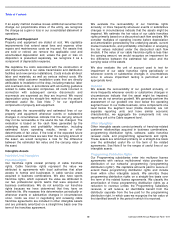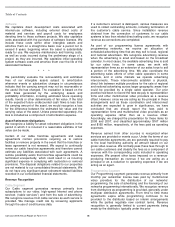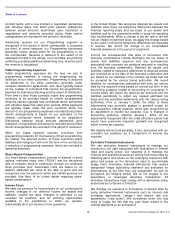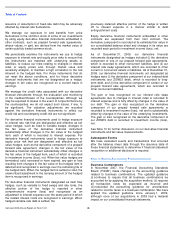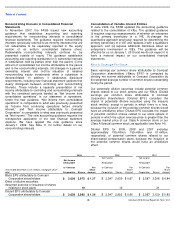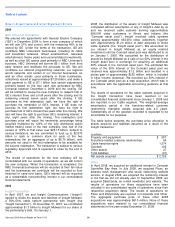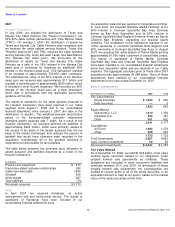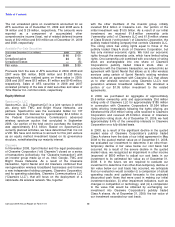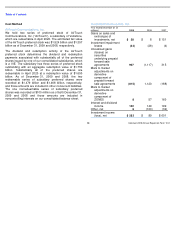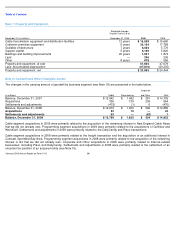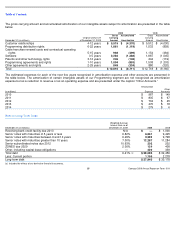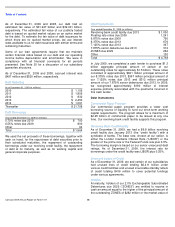Comcast 2009 Annual Report Download - page 55
Download and view the complete annual report
Please find page 55 of the 2009 Comcast annual report below. You can navigate through the pages in the report by either clicking on the pages listed below, or by using the keyword search tool below to find specific information within the annual report.
Table of Contents
Comcast 2009 Annual Report on Form 10-K
46
Software
We capitalize direct development costs associated with
internal-use software, including external direct costs of
material and services and payroll costs for employees
devoting time to these software projects. We also capitalize
costs associated with the purchase of software licenses. We
include these costs within other intangible assets and
amortize them on a straight-line basis over a period not to
exceed 5 years, beginning when the asset is substantially
ready for use. We expense maintenance and training costs,
as well as costs incurred during the preliminary stage of a
project, as they are incurred. We capitalize initial operating
system software costs and amortize them over the life of the
associated hardware.
* * *
We periodically evaluate the recoverability and estimated
lives of our intangible assets subject to amortization
whenever events or substantive changes in circumstances
indicate that the carrying amount may not be recoverable or
the useful life has changed. The evaluation is based on the
cash flows generated by the underlying assets and
profitability information, including estimated future operating
results, trends or other determinants of fair value. If the total
of the expected future undiscounted cash flows is less than
the carrying amount of the asset, we would recognize a loss
for the difference between the estimated fair value and the
carrying value of the asset. Unless presented separately, the
loss is included as a component of amortization expense.
Asset Retirement Obligations
We recognize a liability for asset retirement obligations in the
period in which it is incurred if a reasonable estimate of fair
value can be made.
Certain of our cable franchise agreements and lease
agreements contain provisions requiring us to restore
facilities or remove property in the event that the franchise or
lease agreement is not renewed. We expect to continually
renew our cable franchise agreements and therefore cannot
estimate any liabilities associated with such agreements. A
remote possibility exists that franchise agreements could be
terminated unexpectedly, which could result in us incurring
significant expense in complying with restoration or removal
provisions. The disposal obligations related to our properties
are not material to our consolidated financial statements. We
do not have any significant asset retirement-related liabilities
recorded in our consolidated financial statements.
Revenue Recognition
Cable Segment
Our Cable segment generates revenue primarily from
subscriptions to our video, high-speed Internet and phone
services (“cable services”) and from the sale of advertising.
We recognize revenue from cable services as each service is
provided. We manage credit risk by screening applicants
through the use of credit bureau data.
If a customer’s account is delinquent, various measures are
used to collect outstanding amounts, including termination of
the customer’s cable service. Since installation revenue
obtained from the connection of customers to our cable
systems is less than related direct selling costs, we recognize
revenue as connections are completed.
As part of our programming license agreements with
programming networks, we receive an allocation of
scheduled advertising time that we may sell to local, regional
and national advertisers. We recognize advertising revenue
when the advertising is aired and based on the broadcast
calendar. In most cases, the available advertising time is sold
by our sales force. In some cases, we work with
representation firms as an extension of our sales force to sell
a portion of the advertising time. We also coordinate the
advertising sales efforts of other cable operators in some
markets, and in some markets we operate advertising
interconnects. These interconnects establish a physical,
direct link between multiple providers for the sale of regional
and national advertising across larger geographic areas than
could be provided by a single cable operator. Our prior
practice had been to record the fees we pay to representation
firms and other multichannel video providers as a revenue
offset. However, since we are acting as the principal in these
arrangements and as these coordination and interconnect
activities are expected to grow in significance, we have
concluded that we should report the fees paid to
representation firms and multichannel video providers as an
operating expense rather than as a revenue offset.
Accordingly, we changed the presentation for these items for
2008 and 2007, and classified approximately $167 million
and $165 million, respectively, of the fees paid as operating
expenses.
Revenue earned from other sources is recognized when
services are provided or events occur. Under the terms of our
cable franchise agreements, we are generally required to pay
to the local franchising authority an amount based on our
gross video revenue. We normally pass these fees through to
our cable customers and classify the fees as a component of
revenue with the corresponding costs included in operating
expenses. We present other taxes imposed on a revenue-
producing transaction as revenue if we are acting as a
principal or as a reduction to operating expenses if we are
acting as an agent.
Programming Segment
Our Programming segment generates revenue primarily from
monthly per subscriber license fees paid by multichannel
video providers for the distribution of our networks’
programming, the sale of advertising and the licensing of our
networks programming internationally. We recognize revenue
from distributors as programming is provided, generally under
multiyear distribution agreements. From time to time these
agreements expire while programming continues to be
provided to the distributor based on interim arrangements
while the parties negotiate new contract terms. Revenue
recognition is generally limited to current payments being
made by the distributor, typically under the prior


